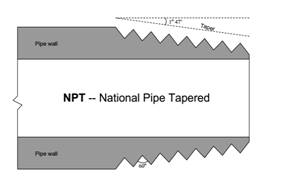The electromagnetic
flow sensors are useful for measuring the movement of conductive liquids. They
are true noninvasive measurements. The operating principle is based on Faraday’s
Law of electromagnetic induction.
“If a conductor of
length L (m) is moving with a velocity v (m/s), perpendicular to
a magnetic field of flux density B (Tesla), then the induced voltage e across the ends of conductor can be expressed as:
a magnetic field of flux density B (Tesla), then the induced voltage e across the ends of conductor can be expressed as:
e
= BLv
The magnetic field, the
direction of the movement of the conductor, and the induced emf are all
perpendicular to each other.”
perpendicular to each other.”
In
the case of electromagnetic flowmeters, the conductor is the liquid flowing
through the pipe, and the length of the conductor is the distance between the
two electrodes, which is equal to the tube diameter. The velocity of the
conductor is proportional to the mean flow velocity of the liquid.
The
generated voltage does not depend on parameters such as pressure, temperature,
viscosity, conductivity, etc. Only a minimal level of conductivity is required
to give this signal a (very small) minimal power.
The
accuracy of these meters can be as low as 0.25% and, in most applications, an
accuracy of 1% is used.
The
traditional magnetic flow meter consists of two units: the measuring probe and
electronic converter-amplifier that transforms this mV signal into one or more
standard analog or digital signals.
The
electrodes are placed at positions where maximum potential differences occur.
The electrodes are electrically isolated from the pipe walls by nonconductive
liners to prevent short-circuiting of electrode signals. The liner also serves as
protection to the flow tube to eliminate galvanic action and possible corrosion
due to metal contacts.
The
main body of a flowmeter and electrodes can be manufactured from stainless
steel, tantalum, titanium, and various other alloys.
The
measuring probe consists of two electrodes made of a non-magnetic material
and is positioned at the inside covered with an electric insulating layer. Commonly used insulating layer are Natural rubber or neoprene, PTFE (Teflon), PFA (Per Fluor Alkoxy), Ceramic.
and is positioned at the inside covered with an electric insulating layer. Commonly used insulating layer are Natural rubber or neoprene, PTFE (Teflon), PFA (Per Fluor Alkoxy), Ceramic.
Coil excitation
The
magnet coils generate a magnetic field that depends on the form of the field
excitation signal. There are several types of flow meters coil excitation.
excitation signal. There are several types of flow meters coil excitation.
(a) DC
excitation: It is only applicable with liquid
metals. DC excitation results in electrolysis and hence they are hardly ever
used.
(b) AC
or Sinusoidal excitation: An alternating current of 50 Hz to
60 Hz in coils creates
the magnetic field to excite the liquid flowing within the pipe. The disadvantage of these applications is that the electronic noise causes the zero point to drift after a certain time. It is essential to manually readjust the zero point at regular time intervals.
the magnetic field to excite the liquid flowing within the pipe. The disadvantage of these applications is that the electronic noise causes the zero point to drift after a certain time. It is essential to manually readjust the zero point at regular time intervals.
(c) Pulsed
DC field: here the converter feeds the magnetic coils with a
pulsed DC (low frequency square wave) current. Because the converter is
provided with the necessary intelligence, it can independently control the zero
point, so that the zero point is stable. This method has lower power
consumption (5-25W).
(d) Capacitive
detection: Here the electrodes, which are in contact with the
medium are replaced by capacitive plates and that function as the electrodes of
a capacitor. For this model the minimum required conductivity is 100 times
lower than for the model with the contact electrodes.
The
installation of the flow sensor may occur in every position, as long as the measuring
instrument is completely filled with the fluid. If the fluid contains solid
particles or fats, the magnetic flow meter is best positioned vertically. When
placing it horizontally, the heavier particles will precipitate and the lighter
particles will come up.
Theoretically
the direction of the flow is not important, as long as the correct electric
connection is used.
At
a low rate of flow (< 1 m/s) the desired accuracy cannot be obtained. The velocity
can be increased by reducing the pipe.
The flow profile is not very important for the magnetic flow meter. In practice,
however,
a straight pipe segment of 5 times the pipe’s diameter is recommended. The
grounding is of vital importance. This is very important because the voltage on
the electrodes amounts to only a few mV.
The
pipes of electromagnetic flowmeters must be full of liquid at all times for
accurate measurement. If the liquid does not make full contact with electrodes,
the high impedance prevents the current flow; hence, measurements cannot be
taken. Also, if the pipe is not full, even if contact is maintained between the
liquid and electrodes, the empty portions of the pipe will lead to
miscalculated flow rates.
Important features
·
Completely obstruction-free and hence no
pressure loss.
·
Highly accurate, better than 1% FS for
higher flow.
·
Wide span, good linearity.
·
Measuring principle not dependent on
pressure, temperature or viscosity.
·
Expensive because of electronics.
·
Minimum conductivity required (5µS/cm).
·
Not dependent on the flow profile
·
No mechanically moving components,
maintenance-free.
·
Ideal for contaminated liquids.



















